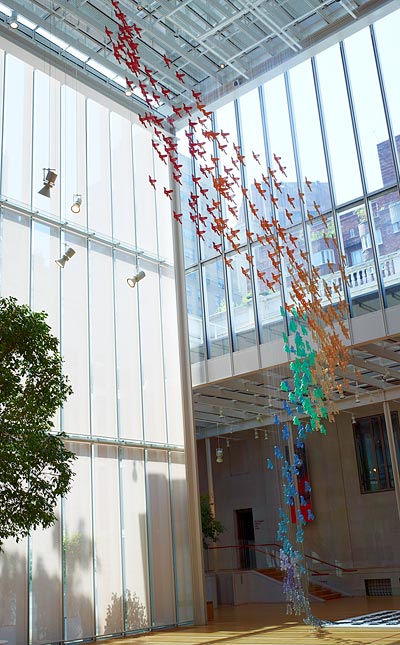Xu Bing: The Living Word

My work and my method of thinking have been my search for the living word.
–Xu Bing
Reflection on language and the nature of writing has been at the core of Xu Bing's art since the beginning of his career in China during the mid-1980s. It is therefore particularly fitting that the Morgan, a library as well as a museum, should present his spectacular installation, The Living Word, a poetic evocation of the relationship between the written word and its meaning.
"In The Living Word," Xu Bing explained, "the dictionary definition of niao (bird) is written on the gallery floor in the simplified text created by Mao. The niao characters then break away from the confines of the literal definition and take flight through the installation space. As they rise into the air, the characters gradually change from the simplified text to standardized Chinese text and finally to the ancient Chinese pictograph for 'bird.' The characters are rainbow colored to create a magical, fairy-tale quality."
The elegance of the shimmering characters that gradually metamorphose into birds as they ascend masks the subversive nature of the work. While the modern, simplified Chinese characters are fixed to the floor, their form and meaning set, earlier forms of scripts embody an increasing sense of freedom as one moves back in time from traditional calligraphy to the original pictographs based on images of nature. Xu Bing said that he chose the bird to suggest "escaping the confines of human written definition."
The title of the installation points to the Buddhist inspiration that informs Xu Bing's work. "Buddhists believe," the artist wrote, "that 'if you look for harmony in the living word, then you will be able to reach Buddha; if you look for harmony in lifeless sentences, you will be unable to save yourself.' . . . My work and my method of thinking have been my search for the living word."
Xu Bing created the first version of The Living Word in 2001 for an exhibition at the Smithsonian Institution's Arthur M. Sackler Gallery in Washington, DC. In a second version a year later, he replaced the Chinese characters with the English dictionary definition for bird. At the Morgan, Xu Bing designed a third version specifically for the soaring space of Renzo Piano's Gilbert Court. Using Chinese language, The Living Word 3 includes more and larger characters than the previous two versions. A selection of Xu Bing's preparatory drawings for this installation is also on view.
Xu Bing was born in Chongqing, China, in 1955 and grew up in Beijing. After spending two years working in the countryside during the Cultural Revolution, he enrolled in 1977 at the Central Academy of Fine Arts in Beijing, where his studies focused on drawing and printmaking. He gained international recognition in the late 1980s with Book from the Sky, a monumental installation composed of books and scrolls printed with what appear to be traditional Chinese characters. The texts are illegible, however, because all the characters were invented by the artist, exposing the unreliability of the written word as a primary vehicle of communication. In 1990 Xu Bing moved to the United States where his work has continued to focus on written language. In 1999 he was awarded a MacArthur Fellowship for "his originality, creativity, self-direction, and capacity to contribute importantly to society, particularly in printmaking and calligraphy." His work has been exhibited in China, Japan, Australia, the United States, and all over Europe. In 2008 Xu Bing was appointed vice president of the Central Academy of Fine Arts in Beijing. He now divides his time between Beijing and New York.
About Chinese Characters
Chinese characters are among the oldest continuously used forms of writing in the world, dating back to well before 1000 B.C. Many of the ancient characters were pictograms, or symbols that visually convey meaning through their resemblance to physical things. Some of the early characters look more like representational drawings than writing, and though they evolved over time—rounded edges becoming square, strokes being added, subtracted, and changed—they can still be found in the language today. For instance the ancient version of the character 鸟 (bird) which appears in The Living Word, has a beak, an eye, wings, claws and a tail. Over many thousands of years the rounded edges became more angular and elements were combined or removed. Although the resemblance to a bird has diminished over time, comparing different historical versions of the character allows one to identify some of the visual elements still present in the modern form.
The installation of The Living Word 3 is made possible by a donation from Susanna and Livio Borghese and further underwritten by Clement and Elizabeth Moore, Cynthia Hazen Polsky and Leon B. Polsky, and The Ricciardi Family Exhibition Fund, in honor of Parker Gilbert and in appreciation of his many contributions to the Morgan Library & Museum. Generous support is also provided by the American Friends of the Shanghai Museum, with additional assistance from the DeBevoise Calello Family, Helen Little, and Xiling Group.